Page 1977 of 3383
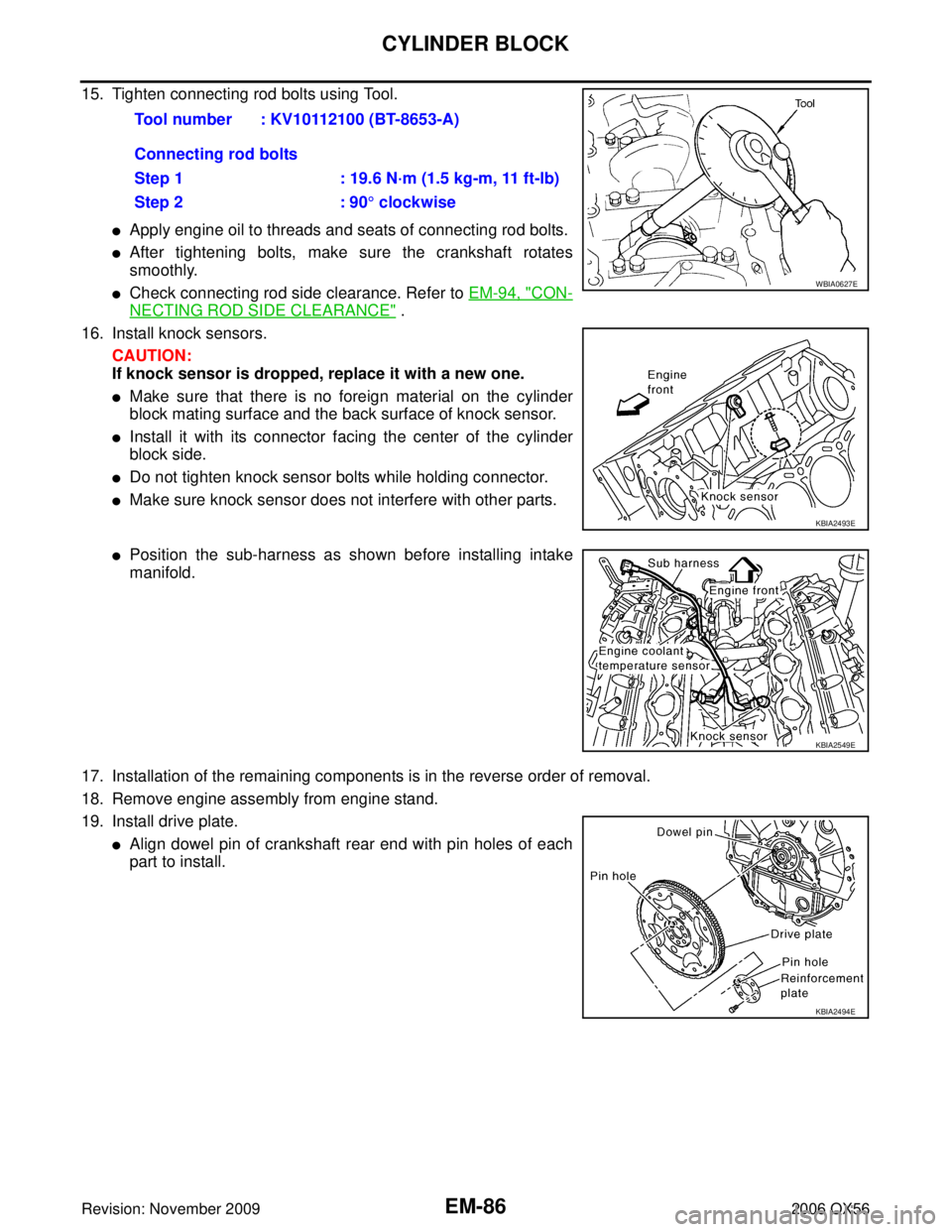
EM-86Revision: November 2009
CYLINDER BLOCK
2006 QX56
15. Tighten connecting rod bolts using Tool.
�Apply engine oil to threads and seats of connecting rod bolts.
�After tightening bolts, make sure the crankshaft rotates
smoothly.
�Check connecting rod side clearance. Refer to EM-94, "CON-
NECTING ROD SIDE CLEARANCE" .
16. Install knock sensors. CAUTION:
If knock sensor is dropped, replace it with a new one.
�Make sure that there is no foreign material on the cylinder
block mating surface and the back surface of knock sensor.
�Install it with its connector facing the center of the cylinder
block side.
�Do not tighten knock sensor bolts while holding connector.
�Make sure knock sensor does not interfere with other parts.
�Position the sub-harness as shown before installing intake
manifold.
17. Installation of the remaining components is in the reverse order of removal.
18. Remove engine assembly from engine stand.
19. Install drive plate.
�Align dowel pin of crankshaft rear end with pin holes of each
part to install. Tool number : KV10112100 (BT-8653-A)
Connecting rod bolts
Step 1
: 19.6 N·m (1.5 kg-m, 11 ft-lb)
Step 2 : 90° clockwise
WBIA0627E
KBIA2493E
KBIA2549E
KBIA2494E
Page 2006 of 3383
EX-1
EXHAUST SYSTEM
B ENGINE
CONTENTS
C
DE
F
G H
I
J
K L
M
SECTION
A
EX
Revision: November 2009 2006 QX56
PREPARATION ......................................................
..... 2
Special Service Tool ............................................ ..... 2
Commercial Service Tools ................................... ..... 2
EXHAUST SYSTEM ................................................... 3 Checking Exhaust System ...................................
..... 3
Removal and Installation ..................................... ..... 3
REMOVAL ........................................................ ..... 4
INSTALLATION ................................................ ..... 4
INSPECTION AFTER INSTALLATION ............. ..... 4
Page 2008 of 3383
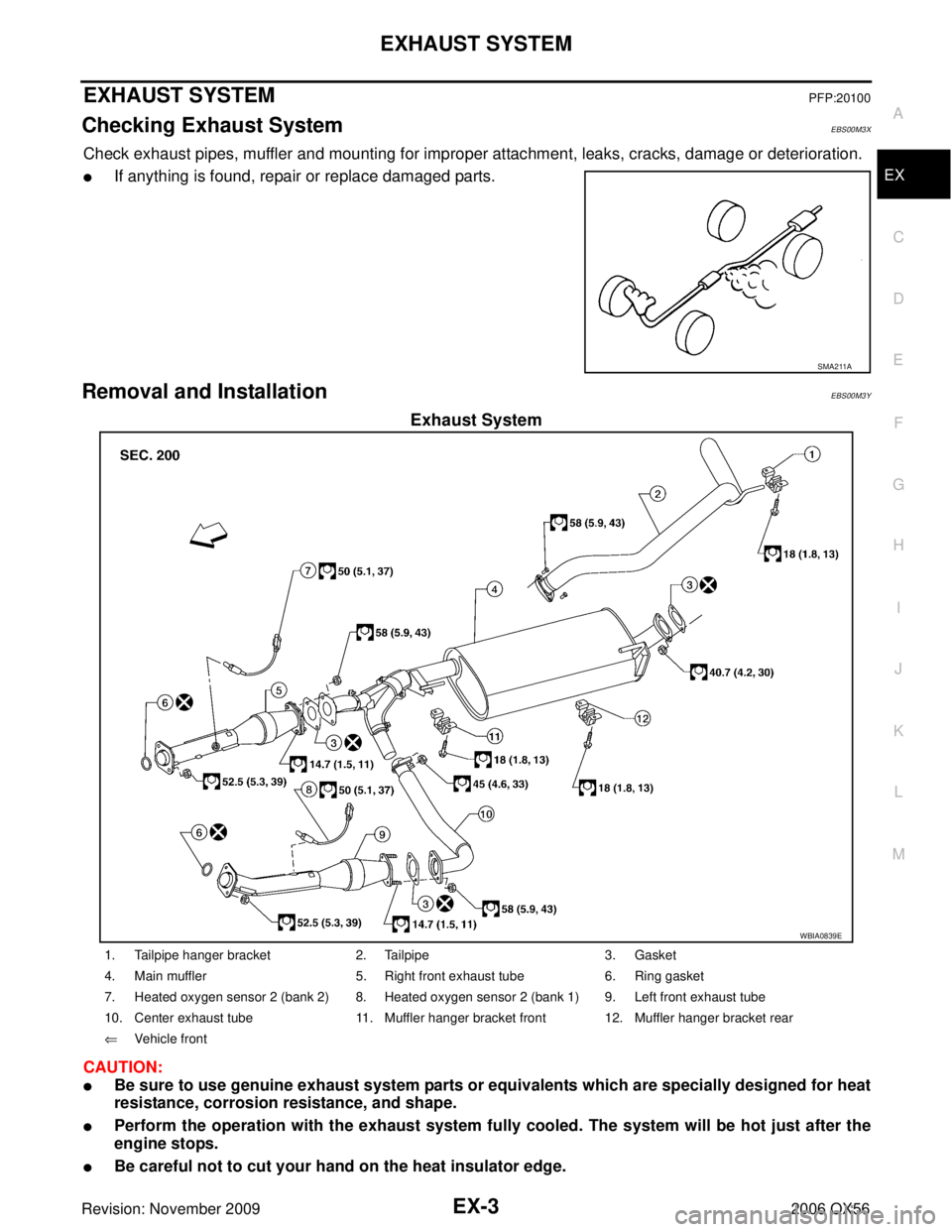
EXHAUST SYSTEMEX-3
C
DE
F
G H
I
J
K L
M A
EX
Revision: November 2009 2006 QX56
EXHAUST SYSTEMPFP:20100
Checking Exhaust SystemEBS00M3X
Check exhaust pipes, muffler and mounting for improper attachment, leaks, cracks, damage or deterioration.
�If anything is found, repair or replace damaged parts.
Removal and InstallationEBS00M3Y
Exhaust System
CAUTION:
�Be sure to use genuine exhaust system parts or equivalents which are specially designed for heat
resistance, corrosion resistance, and shape.
�Perform the operation with the exhaust system fully cooled. The system will be hot just after the
engine stops.
�Be careful not to cut your hand on the heat insulator edge.
SMA211A
WBIA0839E
1. Tailpipe hanger bracket2. Tailpipe3. Gasket
4. Main muffler 5. Right front exhaust tube6. Ring gasket
7. Heated oxygen sensor 2 (bank 2) 8. Heated oxygen sensor 2 (bank 1) 9. Left front exhaust tube
10. Center exhaust tube 11. Muffler hanger bracket front 12. Muffler hanger bracket rear
⇐ Vehicle front
Page 2009 of 3383
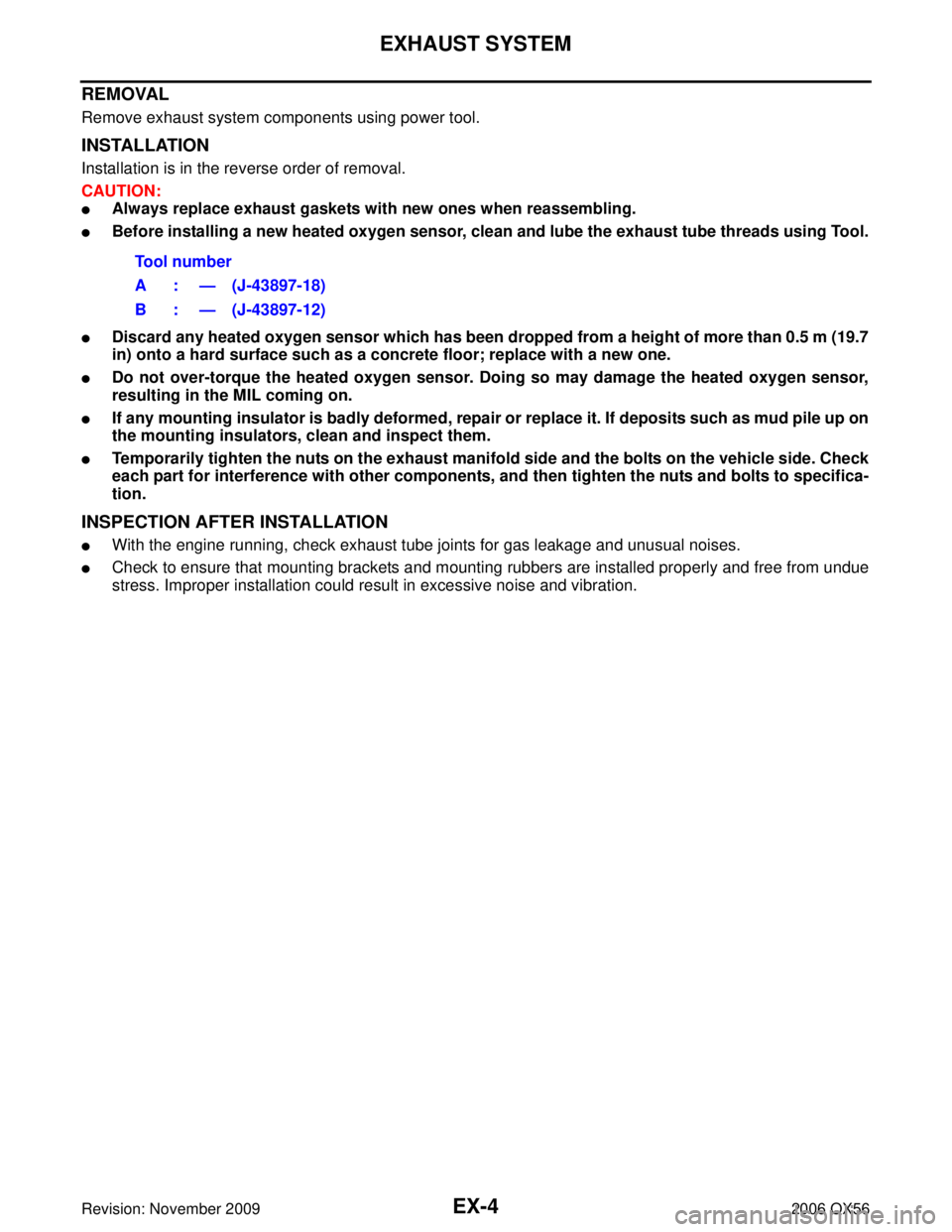
EX-4Revision: November 2009
EXHAUST SYSTEM
2006 QX56
REMOVAL
Remove exhaust system components using power tool.
INSTALLATION
Installation is in the reverse order of removal.
CAUTION:
�Always replace exhaust gaskets with new ones when reassembling.
�Before installing a new heated oxygen sensor, clean and lube the exhaust tube threads using Tool.
�Discard any heated oxygen sensor which has been dropped from a height of more than 0.5 m (19.7
in) onto a hard surface such as a concrete floor; replace with a new one.
�Do not over-torque the heated oxygen sensor. Doing so may damage the heated oxygen sensor,
resulting in the MIL coming on.
�If any mounting insulator is badly deformed, repair or replace it. If deposits such as mud pile up on
the mounting insulators, clean and inspect them.
�Temporarily tighten the nuts on the exhaust manifold side and the bolts on the vehicle side. Check
each part for interference with other components, and then tighten the nuts and bolts to specifica-
tion.
INSPECTION AFTER INSTALLATION
�With the engine running, check exhaust tube joints for gas leakage and unusual noises.
�Check to ensure that mounting brackets and mounting rubbers are installed properly and free from undue
stress. Improper installation could result in excessive noise and vibration. Tool number
A : — (J-43897-18)
B : — (J-43897-12)
Page 2014 of 3383
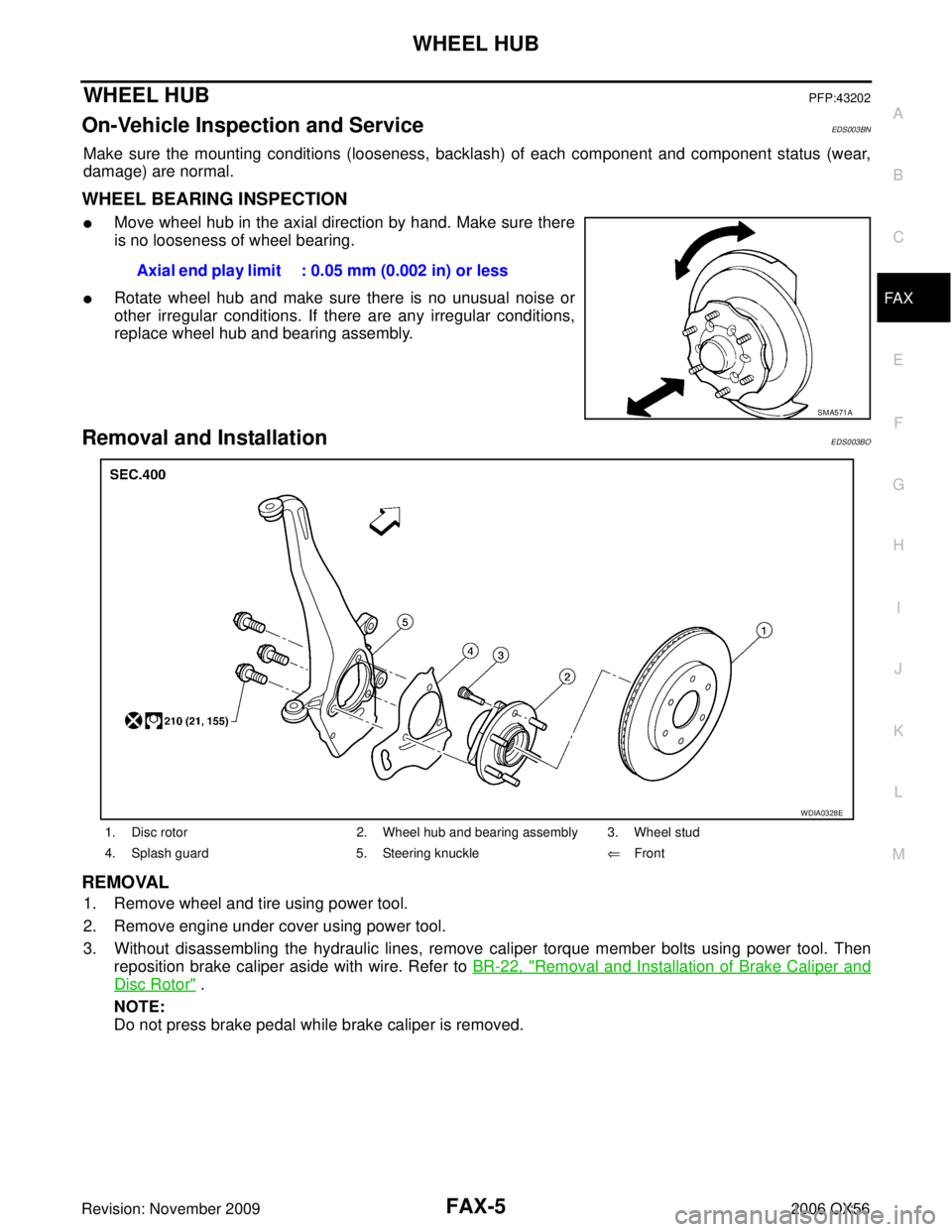
WHEEL HUBFAX-5
CE F
G H
I
J
K L
M A
B
FA X
Revision: November 2009 2006 QX56
WHEEL HUBPFP:43202
On-Vehicle Inspection and ServiceEDS003BN
Make sure the mounting conditions (looseness, backlash) of each component and component status (wear,
damage) are normal.
WHEEL BEARING INSPECTION
�Move wheel hub in the axial direction by hand. Make sure there
is no looseness of wheel bearing.
�Rotate wheel hub and make sure there is no unusual noise or
other irregular conditions. If there are any irregular conditions,
replace wheel hub and bearing assembly.
Removal and InstallationEDS003BO
REMOVAL
1. Remove wheel and tire using power tool.
2. Remove engine under cover using power tool.
3. Without disassembling the hydraulic lines, remove caliper torque member bolts using power tool. Then
reposition brake caliper aside with wire. Refer to BR-22, "
Removal and Installation of Brake Caliper and
Disc Rotor" .
NOTE:
Do not press brake pedal while brake caliper is removed. Axial end play limit : 0.05 mm (0.002 in) or less
SMA571A
1. Disc rotor
2. Wheel hub and bearing assembly 3. Wheel stud
4. Splash guard 5. Steering knuckle⇐Front
WDIA0328E
Page 2016 of 3383
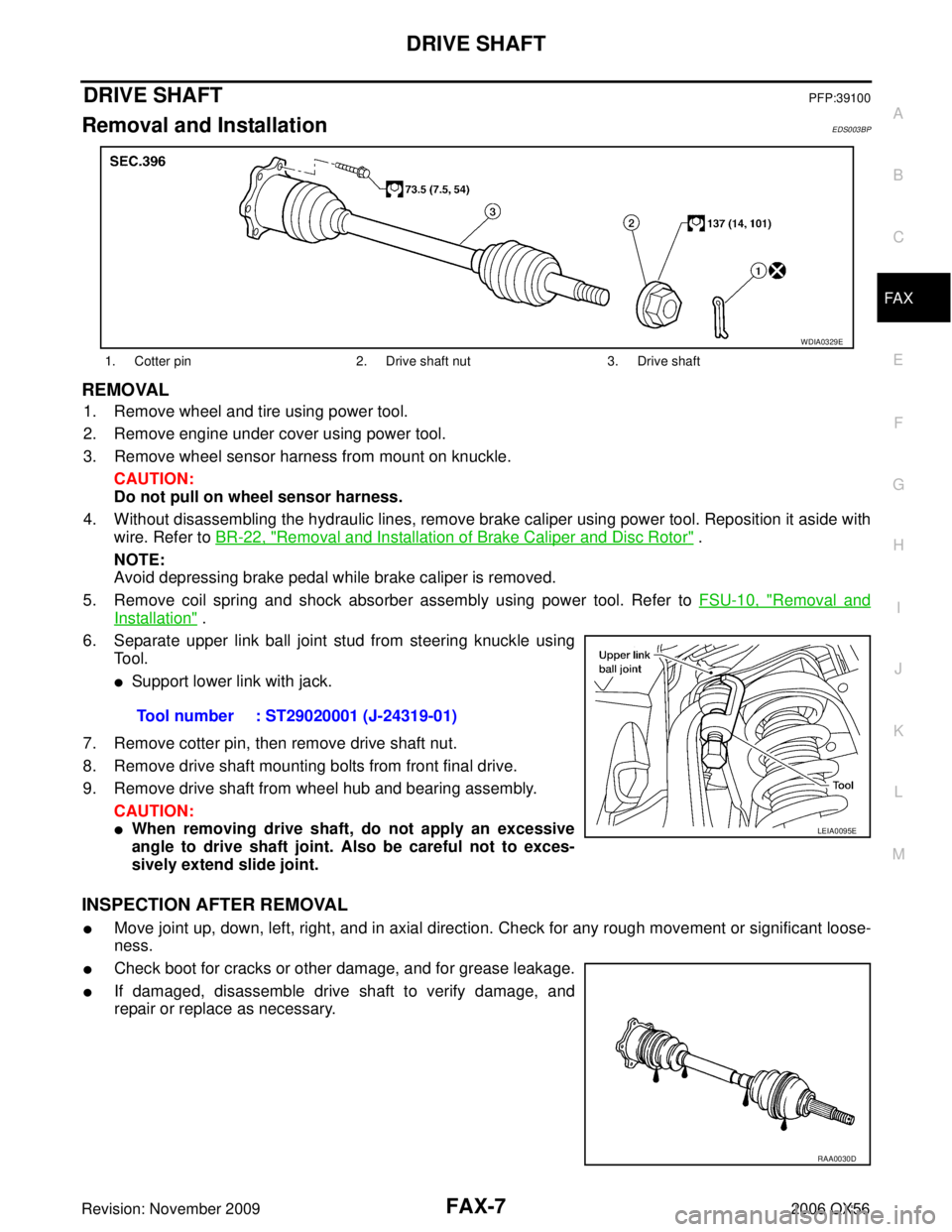
DRIVE SHAFTFAX-7
CE F
G H
I
J
K L
M A
B
FA X
Revision: November 2009 2006 QX56
DRIVE SHAFTPFP:39100
Removal and InstallationEDS003BP
REMOVAL
1. Remove wheel and tire using power tool.
2. Remove engine under cover using power tool.
3. Remove wheel sensor harness from mount on knuckle.
CAUTION:
Do not pull on wheel sensor harness.
4. Without disassembling the hydraulic lines, remove brake caliper using power tool. Reposition it aside with wire. Refer to BR-22, "
Removal and Installation of Brake Caliper and Disc Rotor" .
NOTE:
Avoid depressing brake pedal while brake caliper is removed.
5. Remove coil spring and shock absorber assembly using power tool. Refer to FSU-10, "
Removal and
Installation" .
6. Separate upper link ball joint stud from steering knuckle using To o l .
�Support lower link with jack.
7. Remove cotter pin, then remove drive shaft nut.
8. Remove drive shaft mounting bolts from front final drive.
9. Remove drive shaft from wheel hub and bearing assembly. CAUTION:
�When removing drive shaft, do not apply an excessive
angle to drive shaft joint. Also be careful not to exces-
sively extend slide joint.
INSPECTION AFTER REMOVAL
�Move joint up, down, left, right, and in axial direction. Check for any rough movement or significant loose-
ness.
�Check boot for cracks or other damage, and for grease leakage.
�If damaged, disassemble drive shaft to verify damage, and
repair or replace as necessary.
1. Cotter pin 2. Drive shaft nut3. Drive shaft
WDIA0329E
Tool number : ST29020001 (J-24319-01)
LEIA0095E
RAA0030D
Page 2030 of 3383
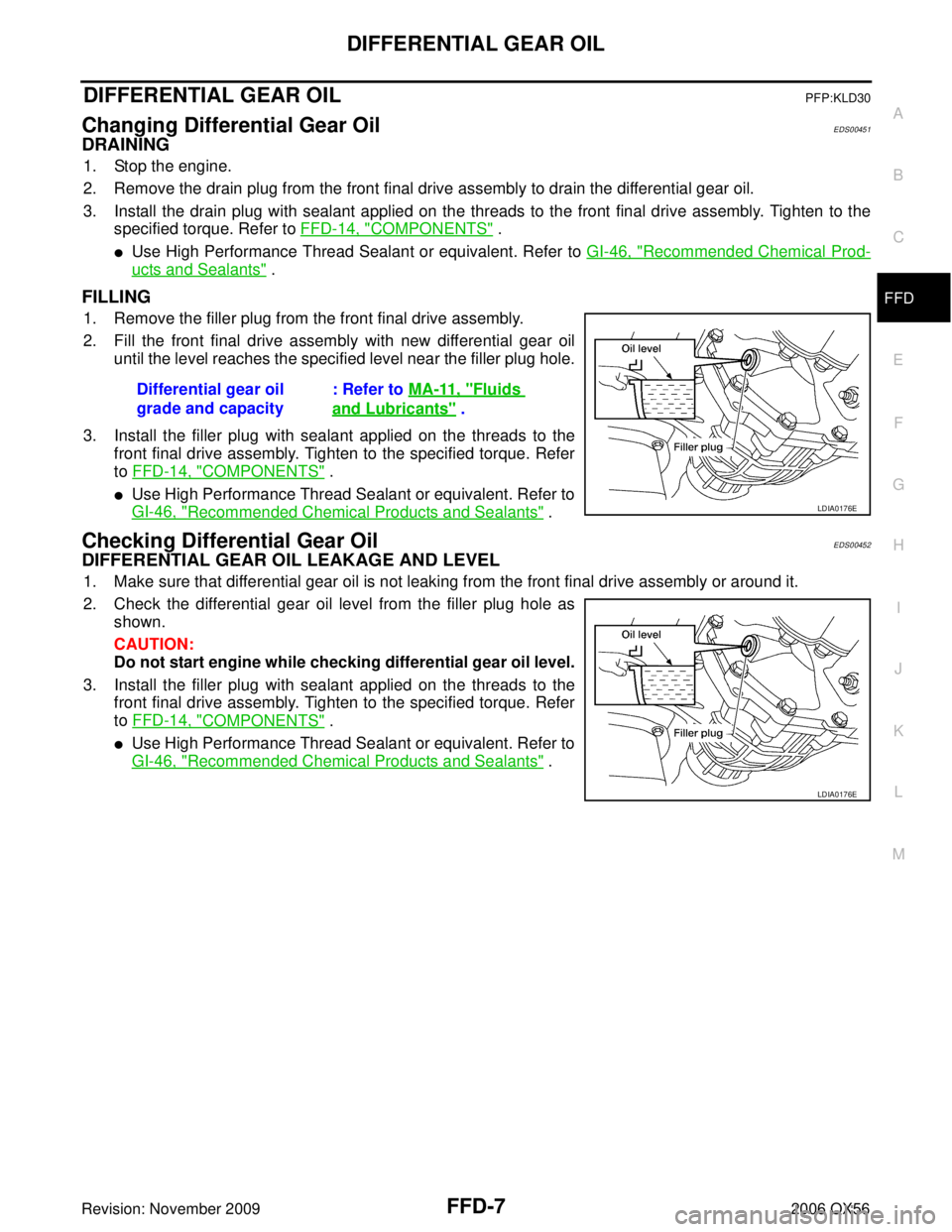
DIFFERENTIAL GEAR OILFFD-7
CE F
G H
I
J
K L
M A
B
FFD
Revision: November 2009 2006 QX56
DIFFERENTIAL GEAR OILPFP:KLD30
Changing Differential Gear OilEDS00451
DRAINING
1. Stop the engine.
2. Remove the drain plug from the front final drive assembly to drain the differential gear oil.
3. Install the drain plug with sealant applied on the threads to the front final drive assembly. Tighten to the
specified torque. Refer to FFD-14, "
COMPONENTS" .
�Use High Performance Thread Sealant or equivalent. Refer to GI-46, "Recommended Chemical Prod-
ucts and Sealants" .
FILLING
1. Remove the filler plug from the front final drive assembly.
2. Fill the front final drive assembly with new differential gear oil
until the level reaches the specified level near the filler plug hole.
3. Install the filler plug with sealant applied on the threads to the front final drive assembly. Tighten to the specified torque. Refer
to FFD-14, "
COMPONENTS" .
�Use High Performance Thread Sealant or equivalent. Refer to
GI-46, "
Recommended Chemical Products and Sealants" .
Checking Differential Gear OilEDS00452
DIFFERENTIAL GEAR OIL LEAKAGE AND LEVEL
1. Make sure that differential gear oil is not leaking from the front final drive assembly or around it.
2. Check the differential gear oil level from the filler plug hole as
shown.
CAUTION:
Do not start engine while checking differential gear oil level.
3. Install the filler plug with sealant applied on the threads to the front final drive assembly. Tighten to the specified torque. Refer
to FFD-14, "
COMPONENTS" .
�Use High Performance Thread Sealant or equivalent. Refer to
GI-46, "
Recommended Chemical Products and Sealants" .
Differential gear oil
grade and capacity
: Refer to
MA-11, "
Fluids
and Lubricants" .
LDIA0176E
LDIA0176E
Page 2056 of 3383
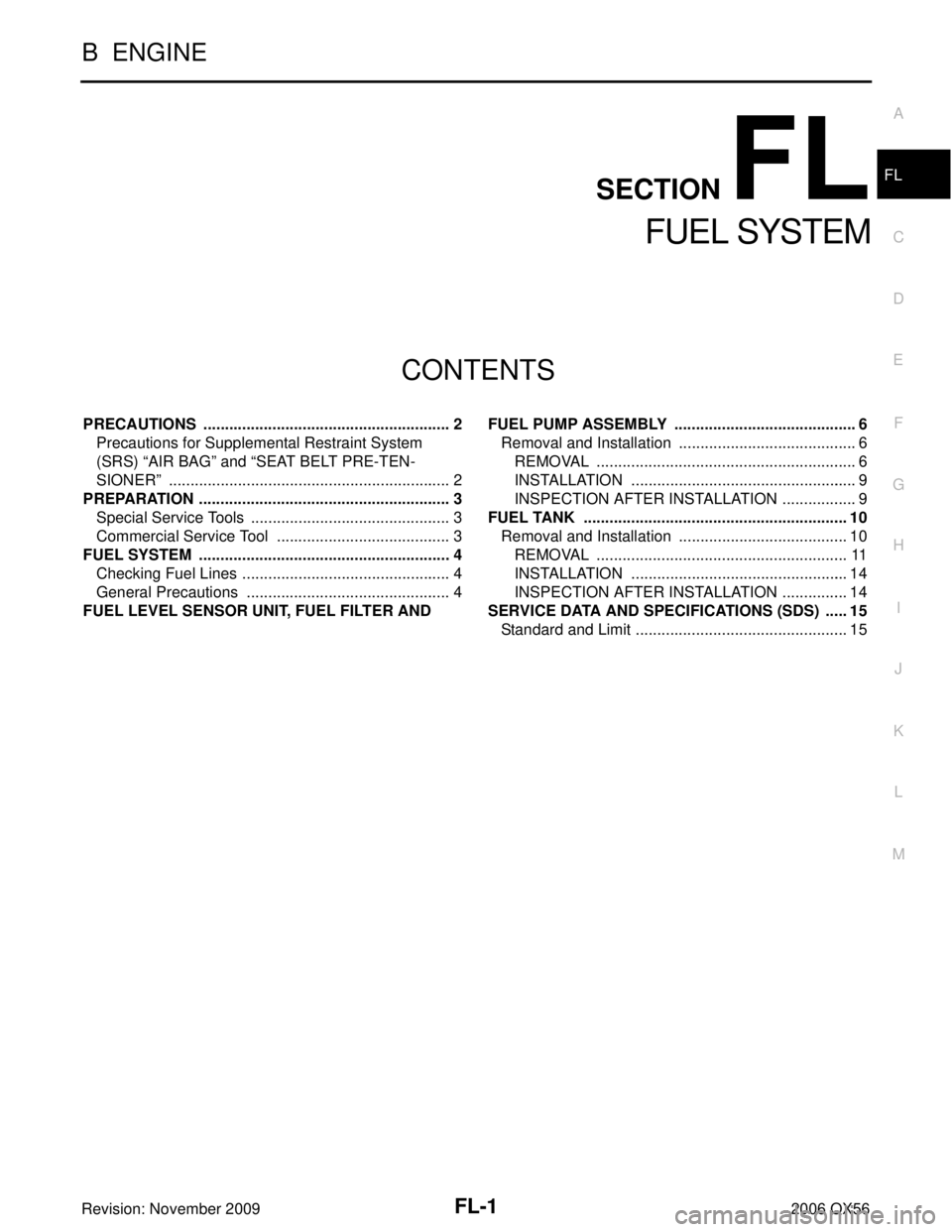
FL-1
FUEL SYSTEM
B ENGINE
CONTENTS
C
DE
F
G H
I
J
K L
M
SECTION
A
FL
Revision: November 2009 2006 QX56
PRECAUTIONS .....................................................
..... 2
Precautions for Supplemental Restraint System
(SRS) “AIR BAG” and “SEAT BELT PRE-TEN-
SIONER” ............................................................. ..... 2
PREPARATION ...................................................... ..... 3
Special Service Tools .......................................... ..... 3
Commercial Service Tool .................................... ..... 3
FUEL SYSTEM ........................................................... 4 Checking Fuel Lines ................................................. 4
General Precautions ........................................... ..... 4
FUEL LEVEL SENSOR UNIT, FUEL FILTER AND FUEL PUMP ASSEMBLY ......................................
..... 6
Removal and Installation ..................................... ..... 6
REMOVAL ........................................................ ..... 6
INSTALLATION ................................................ ..... 9
INSPECTION AFTER INSTALLATION ............. ..... 9
FUEL TANK ........................................................... ... 10
Removal and Installation ..................................... ... 10
REMOVAL ........................................................ ... 11
INSTALLATION ................................................ ... 14
INSPECTION AFTER INSTALLATION ............. ... 14
SERVICE DATA AND SPECIFICATIONS (SDS) ... ... 15
Standard and Limit ............................................... ... 15